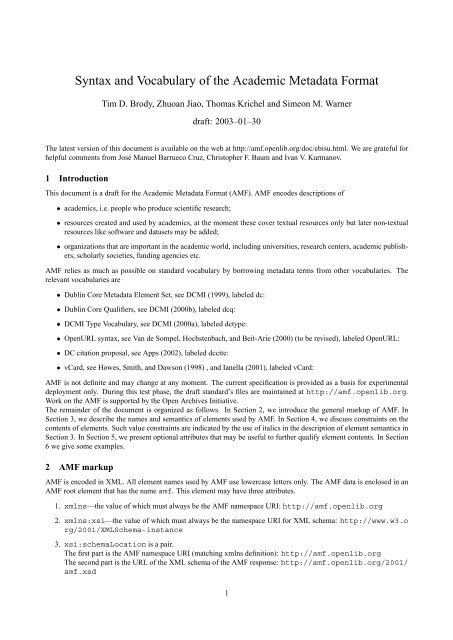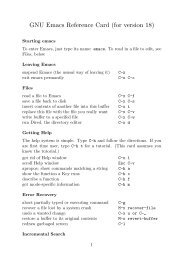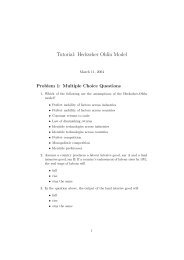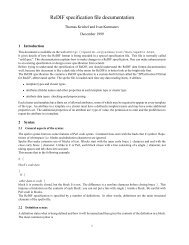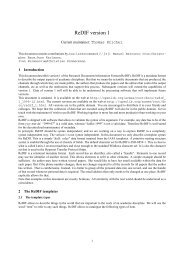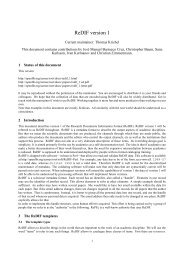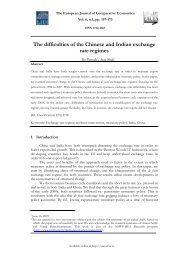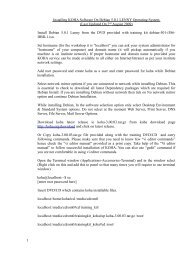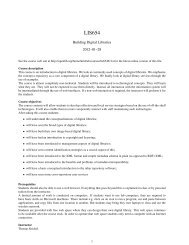A4 size paper - amf
A4 size paper - amf
A4 size paper - amf
- No tags were found...
You also want an ePaper? Increase the reach of your titles
YUMPU automatically turns print PDFs into web optimized ePapers that Google loves.
Syntax and Vocabulary of the Academic Metadata FormatTim D. Brody, Zhuoan Jiao, Thomas Krichel and Simeon M. Warnerdraft: 2003–01–30The latest version of this document is available on the web at http://<strong>amf</strong>.openlib.org/doc/ebisu.html. We are grateful forhelpful comments from José Manuel Barrueco Cruz, Christopher F. Baum and Ivan V. Kurmanov.1 IntroductionThis document is a draft for the Academic Metadata Format (AMF). AMF encodes descriptions of• academics, i.e. people who produce scientific research;• resources created and used by academics, at the moment these cover textual resources only but later non-textualresources like software and datasets may be added;• organizations that are important in the academic world, including universities, research centers, academic publishers,scholarly societies, funding agencies etc.AMF relies as much as possible on standard vocabulary by borrowing metadata terms from other vocabularies. Therelevant vocabularies are• Dublin Core Metadata Element Set, see DCMI (1999), labeled dc:• Dublin Core Qualifiers, see DCMI (2000b), labeled dcq:• DCMI Type Vocabulary, see DCMI (2000a), labeled dctype:• OpenURL syntax, see Van de Sompel, Hochstenbach, and Beit-Arie (2000) (to be revised), labeled OpenURL:• DC citation proposal, see Apps (2002), labeled dccite:• vCard, see Howes, Smith, and Dawson (1998) , and Ianella (2001), labeled vCard:AMF is not definite and may change at any moment. The current specification is provided as a basis for experimentaldeployment only. During this test phase, the draft standard’s files are maintained at http://<strong>amf</strong>.openlib.org.Work on the AMF is supported by the Open Archives Initiative.The remainder of the document is organized as follows. In Section 2, we introduce the general markup of AMF. InSection 3, we describe the names and semantics of elements used by AMF. In Section 4, we discuss constraints on thecontents of elements. Such value constraints are indicated by the use of italics in the description of element semantics inSection 3. In Section 5, we present optional attributes that may be useful to further qualify element contents. In Section6 we give some examples.2 AMF markupAMF is encoded in XML. All element names used by AMF use lowercase letters only. The AMF data is enclosed in anAMF root element that has the name <strong>amf</strong>. This element may have three attributes.1. xmlns—the value of which must always be the AMF namespace URI: http://<strong>amf</strong>.openlib.org2. xmlns:xsi—the value of which must always be the namespace URI for XML schema: http://www.w3.org/2001/XMLSchema-instance3. xsi:schemaLocation is a pair.The first part is the AMF namespace URI (matching xmlns definition): http://<strong>amf</strong>.openlib.orgThe second part is the URL of the XML schema of the AMF response: http://<strong>amf</strong>.openlib.org/2001/<strong>amf</strong>.xsd1
AMF is an open vocabulary in the sense that the AMF XML schema file allows to place elements from foreign vocabularieswithin the AMF vocabulary. This can be done on the root level of the AMF element, or in any child contents ofthat root element. Foreign element names must be namespace qualified.Example: ... ...In the example, text is a “noun” element. The AMF root element must contain one or more nouns. Nouns arerepeatable. There are four nouns:person a physical personorganization an entity that has physical persons as its memberstexta dctype:textcollection a dctype:collection of resourcesEach instance of a noun element in AMF data that is not an empty element is called an AMF record. All child elementsof AMF records are optional and repeatable. An AMF record admits two types of child elements.The first type are “adjective” elements. Adjectives give further information about nouns. Some adjectives have a nestedstructure. In the example above, title is an adjective.The second type are “verb” elements. Verbs relate one noun to other nouns. Each verb must have one or more nouns aschildren. Verbs must not have adjectives as direct children.3 The elements of AMF3.1 The person and organization nounsThe person noun element describes or refers to a physical person: ...adjectives and verbs... or The organization noun element describes or refers to an organization. An organization is a group of two or morepersons: ...adjectives and verbs... or Both nouns accept the same verbs and adjectives. Therefore they will be collectively referred to as the “p/o” noun in theremainder of this document.3.1.1 The adjectives of the p/o noun unstructured full name, as vCard:FN short name e.g. IMF, as vCard:NickName full name, as vCard:N;FamilyName given name, as vCard:N;GivenName additional name, as vCard:N;AdditionalName honorary prefix, as vCard:N;HonoraryPrefix honorary name, as vCard:N;HonorarySuffix date associated with the p/o, as dc:date URL of homepage postal address as vCard:LABEL telephone number as vCard:TEL;TYPE=pref,voice fax number vCard:TEL;TYPE=pref,fax email as vCard:EMAIL;TYPE=internet,pref for the p/o from a scheme that does not use AMF, as dc:identifier 3.1.2 p/o to p/o verbs an organization is replaced by another an organization replaces another an organization is a part of another an organization has another as a part 2
3.1.3 p/o to text verbs as dc:creator as dc:creator or dc:contributor in the sense of dc:publisher p/o who maintains metadata about the text 3.1.4 p/o to collection verbs p/o responsible for the contents of the collection in the sense of dc:publisher p/o who maintains metadata about the collection 3.2 The text nounThe text noun element describes or refers to a text, independent of its status. Thus a PhD thesis, an article in a learnedjournal, the transcript of a speech etc, are all texts: ...adjectives and verbs... or Note: A journal is not a text, it is a collection. A book may also be a collection if it contains <strong>paper</strong>s by different authors.3.2.1 The adjectives of the text noun as dc:title as dcq:abstract list of uncontrolled keywords, may be subject to a scheme vocabulary to be developed list of classification codes, see section a plain-text statement about the copyright, as dc:rights a plain-text description of the status of the text, say published in a journal,presented at a conference etc. something about the text that is not the status, e.g. a dedication email for the text, not necessarily one of the authors or editors date associated with the text URL of a page where access to the text is explained unstructured full text of citation container tag for structured serial access information that citation can provide title of serial, as OpenURL:title, dccite:journaltitle abbreviated title of serial, as OpenURL:stitle, asdcite:journalabbreviatedtitle identifier (usually ISSN) of journal,as dccite:journalidentifier date on the serial issue cover, as OpenURL:date, as dccite:cronology as OpenURL:volume, as dccite:volume as OpenURL:part, as dcite:number as OpenURL:issue, as dcite:number season of publication (spring or summer or autumn or winter),as OpenURL:ssn, as dcite:cronology quarter of publication (1 or 2 or 3 or 4), as OpenURL:quarter, , as dcite:cronology number of the first page of the text in the serial issue, as OpenURL:spage number of the last page of the text in the serial issue, as OpenURL:epage unstructured page data, as OpenURL:pages, as dccite:pagination article number, in the absence of pagination, as OpenURL:artnum a container for full-text file information; it may be repeated for each component file. URL for the file itself the function of the file in the text, e.g. main text, appendix same as dc:format, encoded in Internet Media Types, see IANA (2001) text that explains access to the file, as dc:rights 3
a container for a reference made by the text text of reference to context of the citation a text type an identifier for the text from a scheme that does not use AMF, as dc:identifier 3.2.2 Text to person/organization verbs in the sense of dc:publisher 3.2.3 Text to text verbs as dcq:isReplacedBy as dcq:replaces as dcq:isPartOf as dcq:hasPart for example cited by another, as dcq:isReferencedBy text e.g. cites another text, as dcq:references points to an earlier text that current text is developed from, as dcq:isVersionOf points to a later text developed from the current text, as dcq:hasVersion points to an original text with the same intellectual contents in a different format,as dcq:isFormatOf points to a derived text with the same intellectual contents in a different format,as dcq:hasFormat 3.2.4 Text to collection verbs a text belongs to a collection, as dcq:isPartOf 3.3 The collection nounThe collection noun element is used whenever statements about a set of several texts are being made. This can be aclassification collection, (i.e. all the texts that have the subject classification code), a serial, the <strong>paper</strong>s presented at aconference etc.: ...adjectives and verbs... or 3.3.1 The adjectives of the collection noun same as a journal title, conference title etc. abbreviation, e.g. PRL a plain text description of the collection, as dc:description URL for humans to read more about the collection URL for machines to access the collection 4
a collection type an identifier for the collection from a scheme that does not use AMF, as dc:identifier 3.3.2 Collection to collection verbs as dcq:isReplacedBy as dcq:replaces as dcq:isPartOf as dcq:hasPart 3.3.3 Collection to text verbs as dcq:haspart 3.3.4 Collection to p/o verbs in the sense of dc:publisher p/o who maintain metadata about the collection 4 Element value constraintsThe values of some of the elements are restricted. These content types are listed here.4.1 The date typeThe date adjective is of the form yyyy[–mm[–dd]], where [] encloses optional components. For details, see the datetype definition of XML Schema.4.2 The URL typeThe value must be a valid Uniform Resource Locator.4.3 The email typeThe value must be a valid email address.4.4 The collection type typeThe collection noun covers a wide variety of things in AMF. It is useful to indicate the type of a collection through acontrolled vocabulary.book as OpenURL:book classification a classification schemeproceedings conference proceedings series a series of textsjournal as OpenURL:journal archive an archive of documents4.5 The text type typeThe text noun covers a wide variety of things in AMF. It is useful to indicate the type of a text through a controlledvocabulary.book as OpenURL:book article as OpenURL:articleconference<strong>paper</strong> as OpenURL:proceeding preprint also covers working <strong>paper</strong>s and technical reports,bookitem as OpenURL:bookitem as OpenURL:preprint5 Attributes of elements5.1 The id attributeAll AMF records (i.e. non-empty nouns) may have an id attribute. There are no value constraints for this attribute. Ifa value is set for a particular record, it is assumed that within the scope of a collection of AMF records, the record isuniquely identified by the value of this attribute.5
5.2 The ref attributeAny noun—be it empty or not—may carry a ref attribute. If it is present, its value is identical to the id attribute ofanother record. AMF ref attributes may be resolved to records that have the appropriate identifiers. The details of theresolution algorithm are outside the scope of AMF.5.3 The from and until attributesAll verbs admit two additional attributes: from and until. The values of these attributes must be of the type date.These attributes indicate a time span for which the relationship holds. The dates are inclusive. Example: ... 5.4 The xml:lang attributeAll adjective elements have an optional attribute called lang. It takes the same syntax as in the XML 1.0 specification.It uses values for xml:lang from http://www.w3.org/TR/2000/WD-xml-2e-20000814#sec-lang-tag.As a general rule, the lang attribute refers to the value of the element content. For example Robin des Bois does not mean that the text is a French translation of the adventures of Robin Hood.There are natural exceptions to this rule. For example, if the lang attribute appears at an adjective that is constrained tocontain a URL, it means that text that is found at the URL is written in that language.5.5 The event attributeAll date elements may have an optional attribute event that indicates what happened on the date. The admissible valuesarecreated text was first written, as dcq:created or person was born, as vCard:BDAYavailable date where a person was alive or a resource is available, as dcq:availableissued the formal publication date of a text, as dcq:issuedmodified the date a resource was changed, as as dcq:modifiedExample: 2000-035.6 The xsi:type attributeThe identifier, classification and keyword attributes may have an xsi:type attribute. In that case, controlledvalues for the value have been registered with AMF. The AMF Controlled vocabulary document lists all thecontrolled vocabularies.6 ExamplesNone of the following examples is fictitious. However, the description of the items that is made through the examplesmay not be complete, to conserve space. The Holy Bible The book of GenesisOrganization for Economic Development and CooperationOECDOrganisation de Cooperation deDevelloppement EconomiquesOCDEhttp://www.oecd.org/ http://www.oecd.org/index-fr.htm6
REGULATION IN SERVICES: OECD PATTERNS AND ECONOMIC IMPLICATIONSThe <strong>paper</strong> looks at patterns of regulation in service industriesand explores their implications for service performance.Cette étude analyse les approches règlementaires dans lessecteurs des services et explore leurs implications pourles performances sectorielles dans les pays de l’OCDE.http://www.olis.oecd.org/olis/2001doc.nsf/linkto/eco-wkp(2001)13application/pdfClassification Scheme for Human Rights Documentationhttp://www.huridocs.org/clasengl.htmIvana Cacciaicaccia@web.apc.orgnatural justice universality / relativism philosophy & human rights political theories & human rights democracyliberalismmarxism7
ReferencesApps, Ann (2002). A citation Element Refinement for dc:identifier. available http://epub.mimas.ac.uk/DC/citproposal.html.DCMI (1999). Dublin Core Metadata Element Set, Version 1.1: Reference Description. available at http://www.dublincore.org/documents/dces/.DCMI (2000a). DCMI Type Vocabulary. available at http://www.dublincore.org/documents/2000/07/11/dcmi-type-vocabulary/.DCMI (2000b). Dublin Core Qualifiers. available at http://www.dublincore.org/documents/dcmes-qualifiers/.Howes, Tim, Mark Smith, and Frank Dawson (1998). A MIME Content-Type for Directory Information. RFC 2425,available at http://www.imc.org/rfc2425.IANA (2001). Media Types. available at http://www.isi.edu/in-notes/iana/assignments/media-types/media-types.Ianella, Renato (2001). Representing vCard Objects in RDF/XML. available at http://www.w3.org/TR/vcard-rdf.Van de Sompel, Herbert, Patrick Hochstenbach, and Oren Beit-Arie (2000). OpenURL Syntax Description. availableat http://www.sfxit.com/openurl/openurl.html.8


